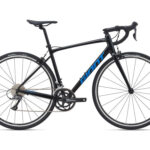Cyclocross Bikes, often abbreviated as CX bikes, might seem niche at first glance, designed for the muddy, obstacle-laden world of cyclocross racing. However, their inherent design features make them surprisingly versatile machines, capable of tackling everything from paved roads to gravel paths and light trails. If you’re considering a bike that can do it all, a cyclocross bike could be an excellent option, albeit with a few considerations.
One common question arises when thinking about using a cyclocross bike beyond its racing purpose: how does it perform in different scenarios compared to bikes specifically designed for road or gravel? Personal experiences offer valuable insights. Someone who initially used a cyclocross bike as their only bike, before adding dedicated road and gravel bikes to their stable, noted some key trade-offs.
Alt text: Cyclocross bike rider navigating a dirt path during a race, demonstrating the bike’s capability on varied terrains.
The primary compromises with a cyclocross frame come down to tire clearance, ride quality, and mounting points. While modern cyclocross bikes have improved in these areas, understanding these limitations is crucial. Older frames, for instance, might be restricted to narrower tires, potentially limiting comfort and grip on rougher surfaces. Always adhere to the manufacturer’s tire clearance recommendations to avoid frame damage, especially in muddy or sandy conditions where debris can accumulate. While a 43mm tire might physically fit in an older frame, running it could lead to paint damage if sufficient clearance for mud and grit isn’t maintained. Newer cyclocross frames often accommodate tires up to 38mm, offering more versatility. Regardless of frame age, aim for at least 2-3mm of clearance on each side of the tire for safe and efficient riding in varied conditions.
Tires are arguably the most impactful upgrade you can make to a cyclocross bike to enhance its performance across different surfaces. Stock tires on cyclocross bikes are often a compromise. Swapping them out for gravel-specific tires like Gravel King SK, Schwalbe G-One, or Continental Terra Speed can dramatically improve speed and comfort, especially when run tubeless at pressures around 35-40psi. Lowering tire pressure, when using tubeless setups, significantly enhances ride quality and grip on uneven surfaces. Conversely, running tubed tires at 40psi or higher with wider widths can lead to a harsh and uncomfortable ride.
Beyond tires, the components of a cyclocross bike play a significant role in its overall feel, particularly when used for road riding. Many cyclocross bikes come equipped with robust aluminum handlebars and aluminum or carbon-wrapped aluminum seatposts, prioritizing durability for racing. However, these components can contribute to a stiff ride, which can be fatiguing on longer road rides. In fact, a German cycling magazine famously tested a specific cyclocross frame and found it to be exceptionally stiff vertically, second only to a stiff aluminum aero road bike.
Alt text: Handlebar area of cyclocross bikes at a race, showing different handlebar and component setups for varied riding styles.
To improve comfort for road-focused riding, consider upgrading the seatpost and handlebars to more compliant carbon options. A flexible carbon seatpost, such as the Specialized Z-shaped post or Fizik R1, can absorb road vibrations and bumps effectively. Similarly, swapping stiff stock handlebars for more flexible aluminum or carbon bars can make a world of difference. Aero handlebars with flat top sections are a popular choice for added comfort and aerodynamics. While bar tape provides cushioning, it doesn’t compensate for the inherent stiffness of the handlebars themselves. When choosing handlebars, look for models with a slight flare in the drops for enhanced control, particularly on gravel. Optimizing stem length is also crucial for achieving a comfortable and efficient riding position.
For riders planning to use their cyclocross bike extensively on gravel, especially in sandy conditions, consider cable routing. External cable routing, common on cyclocross bikes for easy maintenance during races, can be vulnerable to sand and grit ingress, potentially affecting shifting performance. Running full-length cable housing from the handlebars to the derailleurs, as seen on many gravel bikes, minimizes entry points for contaminants and ensures smoother shifting in dusty or sandy environments.
Finally, cyclocross frames often have fewer water bottle mounts compared to dedicated touring or gravel bikes. If you plan on longer rides, especially in warmer weather, assess the distance between water stops on your routes. Supplementing frame-mounted bottles with a half-frame bag and a hydration pack can provide ample water and storage for longer adventures. Frame bags, like those from Apidura, Trek, Topeak, or Shimano Pro, offer convenient storage while still allowing access to water bottles in some designs. Top tube bags are also useful for storing smaller essentials within easy reach.
In conclusion, a cyclocross bike can be a surprisingly adaptable choice for cyclists seeking a versatile machine. While it might not be as purpose-built as a dedicated road or gravel bike, with thoughtful upgrades and an understanding of its limitations, a cyclocross bike can capably handle a wide range of riding conditions, making it a compelling option as an all-around bike.

